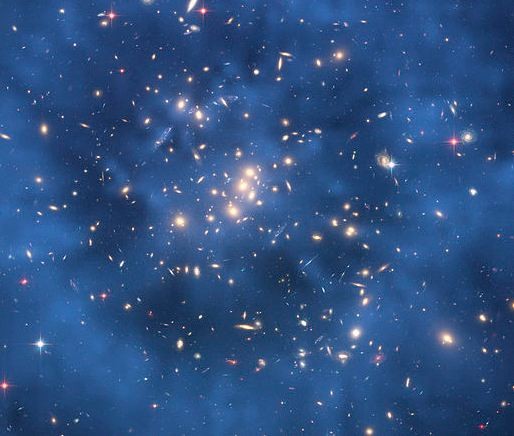The conventional belief is that dark matter is something like ordinary matter's "evil twin". It's invisible but is a mirror image of the real world.
And, by extension, there must be a parallel dark matter universe somewhere out there.
The theory makes for intriguing conversations but new observations have cast doubt on this hunch, however. A new study by the University College London and Switzerland's Ecole Polytechnique Federale de Lausanne (EPFL) concludes dark matter might not be part of a "dark sector" (or a parallel dark matter universe) of particles that mirrors regular matter as some theories suppose.
By studying the collisions of galaxy clusters, researchers showed dark matter clearly doesn't interact with itself, which it would have done were there a parallel dark matter universe. In other words, dark matter barely interacts with anything at all, including the dark matter in other galaxies so there can't be a dark matter universe. Its existence would annihilate this universe and the dark matter universe.
Galaxy clusters contain massive amounts of dark matter. Scientists know that when these clusters collide, they offer a unique glimpse of how dark matter behaves.
Theories of the dark matter universe or sector say this universe is a mirror of the regular universe. The dark matter universe is supposed to contain dark versions of regular matter particles, like dark photons, dark electrons and dark protons.
"Chances are that dark matter is not made up of dark protons interacting with dark protons, and chances are, there is not a mirror universe out there with these dark particles," said David Harvey, a postdoctoral researcher at the EPFL.
"The caveat is that theorists could change some of their parameters, so the field is still open to what (dark matter) could be, but we're narrowing it down."
Dark matter makes up about 90 percent of the matter in galaxy clusters. New research suggests it's unlikely there's an unseen dark matter universe out there since dark matter doesn't splatter or spread out in all directions when galaxy clusters collide.
During the collisions they did observe, scientists saw that individual stars in these galaxies were so far apart they very rarely hit one another. Rather than exploding into massive fireballs, the stars neatly folded together.
Harvey said in between the galaxies is a thick gas full of charged particles. When the galaxy clusters collide, the gas splatters in all directions.
"If we measure the dark matter (after the collision), and should it lie where the galaxies are, we know the dark matter is completely collisionless, and doesn't interact with itself at all," Harvey said.
"And if it should lie where the gas is, we'd say that the dark matter is actually interacting with itself a lot, like a liquid."
By looking at 30 galaxy-cluster mergers, researchers showed that the dark matter behaves more like stars. Dark matter doesn't splatter during these collisions but remains largely unchanged by the merger.
Dark matter can only be detected indirectly by measuring how it warps space, a phenomenon made visible by gravitational lensing. It's invisible because it neither emits nor absorbs light or any other electromagnetic radiation at any significant level.
Based on the standard model of cosmology, the total mass-energy of the known universe contains 4.9 percent ordinary matter; 26.8 percent dark matter and 68.3 percent dark energy.
Thus, dark matter constitutes some 84.5 percent of the total matter in the universe, while dark energy plus dark matter constitute 95.1 percent of the total mass-energy content of the universe.
To conduct the study, researchers looked at 72 galaxy cluster collisions busing two space telescopes. Visible light was recorded by the Hubble Space Telescope and X-rays by the Chandra Observatory, said the BBC.



























